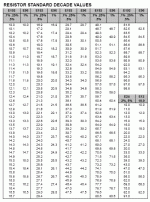Pardon my ignorance, but can someone explain why values such as 221 ohm 22.1 ohm 221K ohm etc for example are nominated on circuit diagrams, standard values , here in Oztralia standard available values are typically 220 ohm, 22k ohm etc.
I assume that such variations from the nominated circuit values are typically not critical
If I were to go and ask for a 221 ohm resistor etc. I’m sure I would get a “kangaroo in the headlights” look from the sales assistant.
Thanks in advance.
I assume that such variations from the nominated circuit values are typically not critical
If I were to go and ask for a 221 ohm resistor etc. I’m sure I would get a “kangaroo in the headlights” look from the sales assistant.
Thanks in advance.
This is depending upon tolerance. 221k would be typical for a resistor with a tolerance of 1%.
So if the shop carries these there won't be any strange look on the face of the salesman !
Regards
Charles
So if the shop carries these there won't be any strange look on the face of the salesman !
Regards
Charles
Parts have a value sequence, a number of values per decade depending on their tolerance.
%10 parts have 12 values per decade
%5 have 24 values
%1 have 96 values
http://lalena.com/audio/electronics/color/
%10 parts have 12 values per decade
%5 have 24 values
%1 have 96 values
http://lalena.com/audio/electronics/color/
These are E96 range values. Sometimes (usually with designs from the USA for some reason) designers specify E96 values where standard E24 parts are quite adequate, so you see 221R instead of 220R (for example).
You'll have to rely on your experience and knowledge to know if the E96 values are critical.
You'll have to rely on your experience and knowledge to know if the E96 values are critical.
We are nice people here so feel free to ask anythinggeorge a said:Pardon my ignorance, ...I’m sure I would get a “kangaroo in the headlights” look from the sales assistant.
Thanks in advance.

- Status
- Not open for further replies.
